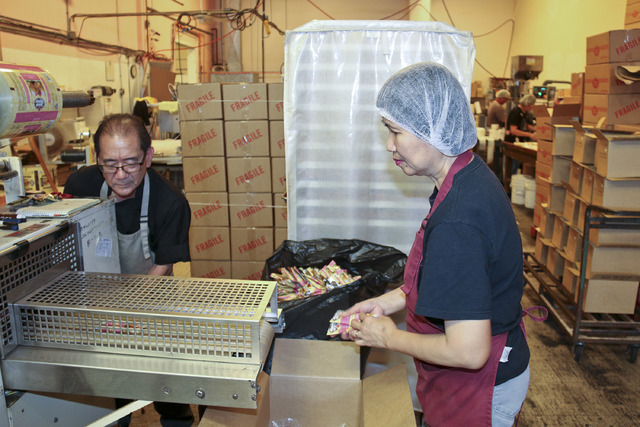LIHUE, Kauai — Merchandise exports from Hawaii soared to $1.5 billion last year, a record high that contributed to the nearly $2.35 trillion in goods and services exported nationwide. ADVERTISING LIHUE, Kauai — Merchandise exports from Hawaii soared to $1.5
LIHUE, Kauai — Merchandise exports from Hawaii soared to $1.5 billion last year, a record high that contributed to the nearly $2.35 trillion in goods and services exported nationwide.
The news from the U.S. Department of Commerce came as no surprise to company officials and business advocates on Kauai, who say that exports are indeed growing.
“The economic numbers reaffirm the importance of bilateral trade as it affects our Hawaii economy,” Kauai Chamber of Commerce President Randy Francisco wrote in an email.
Koloa Rum Company President and CEO Bob Gunter said company officials started exporting their products to Canada about three years ago and have slowly begun to expand those efforts to include France, Australia and Japan.
“As we all know here in Hawaii, we’re uniquely positioned geographically and culturally to take advantage of export opportunities, especially in Asia and the South Pacific,” Gunter said. “Because we get visitors from all over the world, but certainly from those regions, all of us who are in manufacturing in Hawaii have the opportunity to get our products in front of consumers and potential buyers from these international markets.”
Goods that were exported from Hawaii last year were led by a number of sectors, including $479 million in transportation equipment, $426 million in petroleum and coal products, and $153 million in chemicals, according to data from the Department of Commerce’s International Trade Administration.
Hawaii Shippers’ Council President Michael Hansen said the major merchandise exports from Hawaii are refined petroleum products and residual fuel oil from the two crude oil petroleum refineries at Campbell Industrial Park in Kapolei on Oahu.
But those numbers don’t tell the whole story, or paint an accurate picture of Hawaii’s export market, said John Holman, the Pacific Islands director for the United States Department of Commerce’s U.S. and Foreign Commercial Service.
Because of the state’s unique geographic location, ships or aircraft traveling from the West Coast or other U.S. destinations stop routinely in Hawaii to refuel before continuing on to their international destination.
The cargo carried on those ships and planes, as a result, are factored into the state’s export figures, Holman said.
“We know we don’t make aircraft here, we don’t make oil, coal products, petroleum products, or chemicals, so we have to kind of chop out what we know are not Hawaii products and see what are,” Holman explained.
Some of the state’s other top exports are fresh seafood, coffee, bottled water, cosmetic products, and food and beverage products such as macadamia nuts or organic honey.
Perhaps the state’s most successful exports, he said, are service products, such as engineering and architectural consulting services and international tourism or study, which are more difficult to track.
“Because of our proximity to Asia, and even more significantly than that, our cultural affinity with many Asian markets, Hawaii is a great place to do business internationally,” Holman said.
Expanding export opportunities from Hawaii has its challenges.
The high cost of importing essential manufacturing products, such as packaging, agricultural tools or machinery, is an impediment that businesses must face before they even make or sell their goods.
“That’s something that we all face and it creates an unleveled playing field for all of us here in Hawaii because most mainland manufacturers or producers of products don’t have that extra high costs of freight to contend with,” Gunter said.
Companies throughout the state, including those on Kauai, “rely on a lot of ‘outside’ influences to have a successful business” because of the state’s geographically remote location, County Office of Economic Development Director George Costa wrote in an email.
“Unless it is something that is actually grown and manufactured here without outside inputs, it is very difficult to succeed,” Costa explained. “We have limited raw materials with which to make a product, and the product will most likely be made by someone making a wage higher than on the mainland.”
Some local companies involved in the county’s Kauai Made program, he said, “have taken the leap of faith to create a product that is salable to others,” including Aunty Lilikoi, Anahola Granola, Salty Wahine, Kauai Coffee, Ko Bakery, Kauai Kookie, Moloaa Bay Coffee, Tropical Flowers Express, and Hawaiian Organic Noni.
“Their success has not come overnight, but through their diligence and assistance from family, friends and the local business community, they have persevered and become Kauai’s success stories,” Costa said.
Promising areas for growth, Holman said, are markets in Australia and Canada, which also reflect strong visitor arrivals to Hawaii, as well as South Korea, where a free trade agreement was forged three years ago.
Creating free trade agreements with more countries, especially those in Asia, and either repealing the Jones Act or crafting exceptions for Hawaii, will likely encourage more Hawaii businesses to explore export options, Holman and Gunter said.
“I think that, if we could modify or eliminate the onerous requirements of the Jones Act for us here in Hawaii, it would be a tremendous benefit not only for companies who are desiring to export but also for our local residents because everything that comes into Hawaii has that higher cost added to it for freight,” Gunter said.



